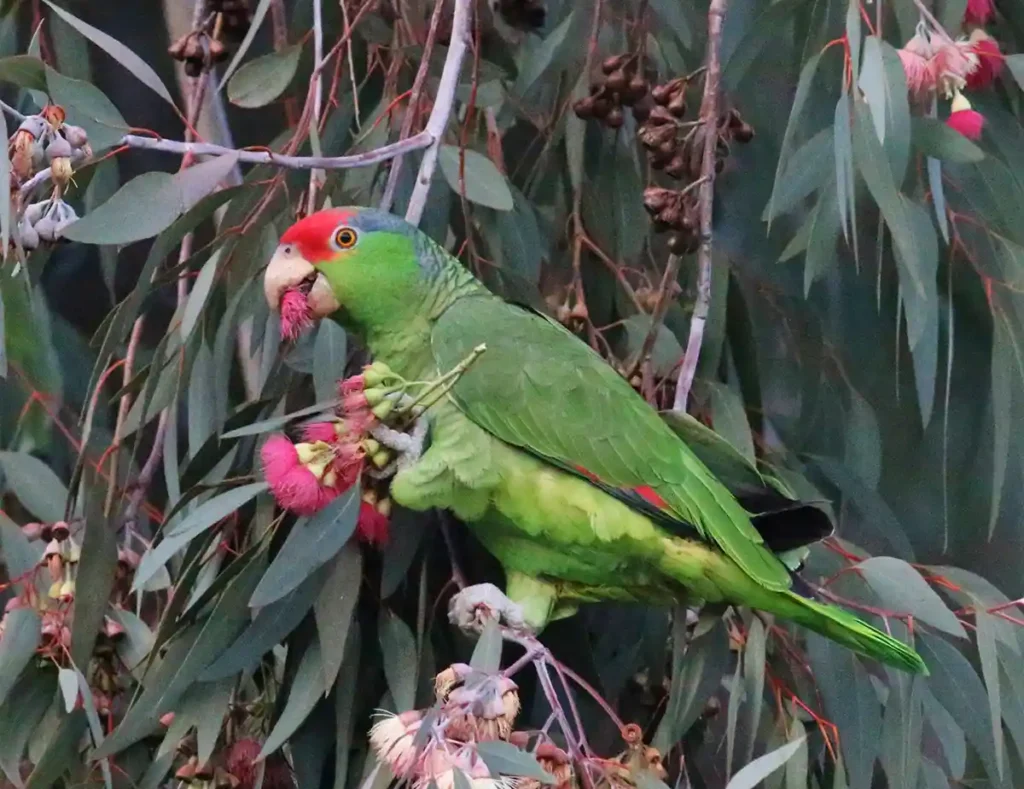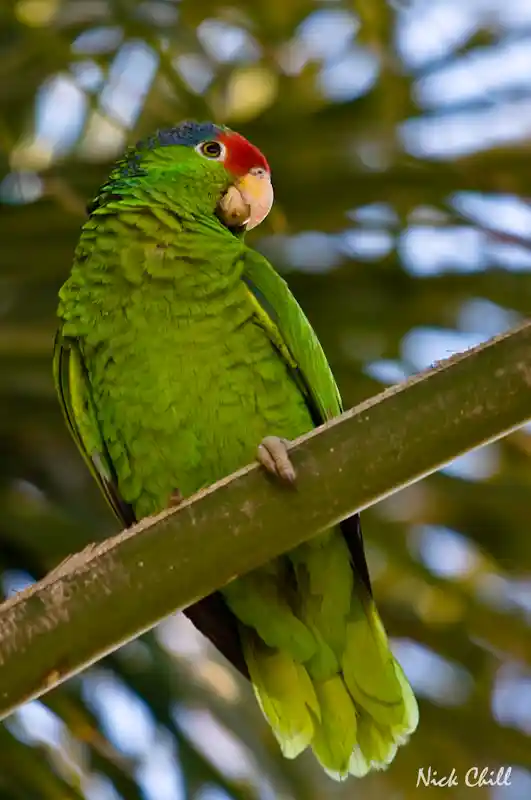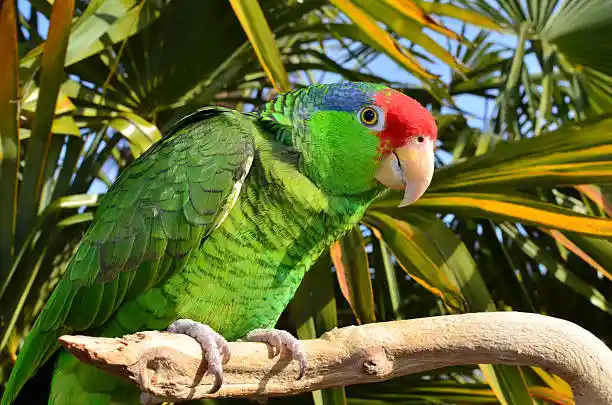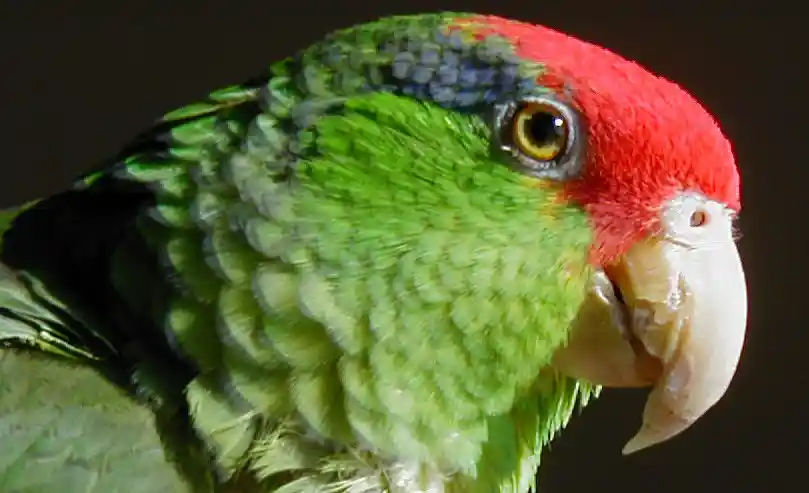
The Red-crowned Parrot (Amazona viridigenalis), also known as Red-crowned Amazon, is a fascinating bird species native to northeastern Mexico and southern Texas. These birds have distinctive fluttery wingbeats and green plumage with a bright red forehead and crown. Unfortunately, the species is in danger of extinction due to habitat loss and the illegal cage bird trade. However, there are ongoing efforts to conserve and protect this bird. In this article, we will explore the history, ecology, conservation efforts, and challenges associated with owning a Red-crowned Parrot. We will also discuss the important role these birds play in biodiversity conservation and ecosystem health.
Ecology of Red-crowned Parrot
Behavior and Ecology of Wild Red-crowned Amazon
Red-crowned Parrots are social birds that live in flocks of up to 30 individuals. They communicate through a range of calls, which can change in response to different situations and contexts. In their native range, they can be found in a variety of habitats, including cloud forests, tropical forests, and arid scrublands. They are active during the day and roost at night in trees. In the wild, they mate for life and find tree cavities near other members of their flock to create a breeding group known as a colony.

Diet
Red-crowned Parrots are omnivores that feed on a variety of food items, including seeds, fruits, flowers, and nectar. They play an important role in seed dispersal and pollination. In the wild, they have adapted to feed on a wide range of plant species, depending on their availability and seasonality. In captivity, it is important to provide a varied diet that mimics their natural diet.
Breeding and Reproduction
Red-crowned Parrots reach sexual maturity at three to four years of age and breed during the spring and early summer months. In the wild, they create breeding groups of up to five pairs, which cooperate to defend their territory and raise their young. The female lays two to four eggs, which hatch after an incubation period of 26 to 28 days. The young fledge after around 9 to 11 weeks.
The breeding of Red-crowned Parrots is threatened by a variety of factors, including habitat loss, nest removal, and competition for nest sites with non-native bird species. In addition, disturbance during the breeding season can lead to abandonment of nests and young. Conservation efforts are needed to protect their nesting sites and reduce disturbance during sensitive periods of the breeding cycle. Overall, understanding the ecology of Red-crowned Parrot is essential for their conservation, as well as the conservation of the habitats and ecosystems they inhabit.
History of Red-crowned Parrot in the United States

The Red-crowned Amazon was first introduced to the United States in the 1960s as a popular pet bird. The initial small number of parrots were imported from Mexico into the Brownsville area of South Texas, and from there they began to spread and establish breeding populations by escaping or being intentionally released from captivity.
Today, the Red-crowned Parrot is found in several large cities in South Texas, including Brownsville and McAllen. Feral breeding populations have also been established in urban communities of southern California, Hawaii, and Puerto Rico. According to Texas Parks and Wildlife Department, the population of Red-crowned Parrots in South Texas is estimated to be around 2,000-3,000 birds, while the population in California is unknown.
Legal Status of Red-crowned Parrot in the United States
The Red-crowned Parrot is protected under the Migratory Bird Treaty Act and considered an endangered species with a status of “threatened” on the IUCN Red List. The U.S. Fish and Wildlife Service announced in 2020 that the Red-crowned Amazon is now a “candidate” species under the Endangered Species Act. This means that the species is being considered for listing as threatened or endangered, and additional research will be conducted to determine if protection is necessary.
Overall, the history of Red-crowned Parrot in the United States is one of both introduction and adaptation, with the species now finding a home in several urban areas across the country. While their numbers have been increasing in some areas, the species still faces significant threats from habitat loss and the illegal cage bird trade.
Red-crowned Parrot in South Texas

The Red-crowned Parrot was first recorded in the United States in the mid-20th century, with the first nesting in Brownsville, Texas in 1968. Since then, the species has become established in South Texas, with the largest populations in the Rio Grande Valley. The birds can often be seen flying over urban areas with distinctive fluttery wingbeats in mornings and evenings. In South Texas, Red-crowned Parrots are found in both urban and rural areas, including suburban parks, residential neighborhoods, agricultural fields, citrus groves, and palm-lined streets.
South Texas plays a critical role in the conservation of the Red-crowned Parrot due to its status as the northernmost extent of the bird’s range in the wild. The state of Texas has recognized the importance of this species and has enacted legal protection for it. The Texas Parks and Wildlife Department has also played a leading role in efforts to conserve the species, including monitoring populations, habitat restoration, and public education.
Partnerships in South Texas to Protect Red-crowned Parrot
Numerous partnerships exist in South Texas to protect the Red-crowned Parrot from threats such as habitat loss and the illegal pet trade. The US Fish and Wildlife Service is working with the National Audubon Society, Texas Parks and Wildlife Department, and other agencies to monitor the species’ population and help implement a conservation plan.
The American Bird Conservancy has also played a leading role in advocating for the conservation of this species, including efforts to protect critical habitat and create safe corridors for the birds. Additionally, local conservation organizations, such as the Valley Nature Center and the Gladys Porter Zoo, are working to educate the public about the importance of Red-crowned Amazon conservation and promote responsible pet ownership.
In conclusion, South Texas is a critical area for the conservation of the Red-crowned Parrot due to its habitat and population in the Rio Grande Valley area. Through partnerships between agencies and organizations and public awareness and involvement, we can help protect this beautiful species and ensure its survival for future generations.
Red-crowned Parrot in California and Other States

The Red-crowned Parrot is not native to California or any other state in the US, but has established breeding populations in urban areas of southern California. The birds were first introduced to the area in the 1960s and 1970s, likely as a result of the illegal cage bird trade. The parrots have also been introduced to other states such as Florida and Hawaii.
The introduction of Red-crowned Amazon to California and other states has both positive and negative impacts on ecosystems. On one hand, the parrots help to disperse seeds, which can aid in reforestation efforts. On the other hand, large flocks of parrots can cause noise pollution, damage to crops and infrastructure, and competition with native species for resources. Additionally, there is concern that the parrots may introduce diseases to native bird populations.
Amazona viridigenalis is recognized as an introduced species in California and other states and is not protected under federal laws such as the Endangered Species Act. However, conservation and preservation efforts exist to protect both the parrots and the ecosystems they inhabit. In California, the National Audubon Society works with local residents to monitor parrot populations, educate the public, and promote conservation efforts. Additionally, the International Union for Conservation of Nature (IUCN) has listed the Red-crowned Parrot as a vulnerable species, highlighting the need for continued conservation and preservation efforts.
Importance in Biodiversity Conservation

The Red-crowned Amazon plays a crucial role in maintaining ecosystem health and biodiversity. As seed dispersers, they help to distribute plant species throughout their native range. They also act as pollinators, playing an important role in the reproduction of various plant species, including epiphytes. In addition, the Red-crowned Parrot serves as prey for several species, acting as an important link in the food chain. Unfortunately, the decline in the population of Red-crowned Parrot can destabilize ecosystems and impact biodiversity in their native range.
Scientific Information and Research on Amazona viridigenalis
Numerous scientific studies have been conducted on the Red-crowned Parrot to better understand its behavior, ecology, and conservation needs. These studies have provided insight into the species’ population size, distribution, and habitat preferences. They have also identified the major threats facing the species and the conservation strategies necessary to address them. Thanks to this research, we now have a better understanding of the importance of Red-crowned Parrot in ecosystem health and biodiversity, and a clear path towards their conservation.
Success Stories and Future Prospects of Red-crowned Parrot Conservation
Despite the challenges facing the Red-crowned Amazon, there have been several success stories in its conservation. Thanks to the efforts of governments, conservation organizations, and concerned individuals, populations of Amazona viridigenalis have started to recover in some areas. For example, in South Texas, partnerships have been established to protect breeding populations of Red-crowned Parrot, and their habitat has been restored through reforestation and the removal of invasive plant species.
In California, efforts are underway to control invasive red-eared slider turtles, which have been known to prey on Red-crowned Parrot nestlings. Looking into the future, it is clear that continued conservation efforts will be necessary to protect the Red-crowned Parrot and ensure its role in maintaining ecosystem health and biodiversity. This will involve increasing awareness of the threats facing the species, promoting responsible ownership practices, and protecting critical habitat. With concerted effort, we can ensure that this unique and important species will continue to thrive in the wild, benefiting ecosystems and biodiversity for generations to come.
